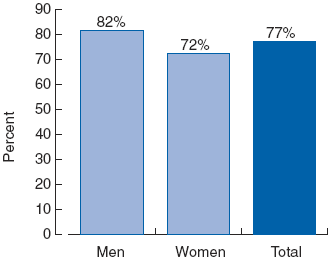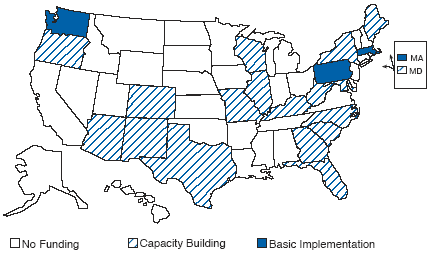
|

|

The Importance of Physical Activity and Good Nutrition
Chronic diseases account for 7 of every 10 U.S. deaths and for more
than 75% of medical care expenditures. In addition, the prolonged illness
and disability associated with many chronic diseases decrease the quality
of life for millions of Americans.
Much of the chronic disease burden is preventable. Physical inactivity
and unhealthy eating contribute to obesity, cancer, cardiovascular
disease, and diabetes. Together, these two behaviors are responsible for
at least 400,000 deaths each year. Only tobacco use causes more
preventable deaths in the United States. People who avoid behaviors
that increase their risk for chronic diseases can expect to live healthier
and longer lives.
The Obesity Epidemic
Following dramatic increases in overweight and obesity among U.S.
adults between 1976-1980 and 1999-2000, obesity has reached epidemic proportions;
nearly 59 million adults are obese. Moreover, the epidemic is not limited
to adults: the percentage of young people who are overweight has more than
doubled in the last 20 years. Of children and adolescents aged 6–19
years, 15%—about 9 million young people—are considered
overweight.
People who are overweight are at increased risk for heart disease, high
blood pressure, diabetes, arthritis-related disabilities, and some
cancers. The estimated annual cost of obesity and overweight in the United
States in 2000 was about $117 billion.
Promoting regular physical activity and healthy eating and creating an
environment that supports these behaviors are essential to reducing this
epidemic of obesity.
Lack of Physical Activity
Regular physical activity reduces people’s risk for heart attack,
colon cancer, diabetes, and high blood pressure, and may reduce their risk
for stroke. It also helps to control weight; contributes to healthy bones,
muscles, and joints; reduces falls among older adults; helps to relieve the
pain of arthritis; reduces symptoms of anxiety and depression; and is
associated with fewer hospitalizations, physician visits, and medications.
Moreover, physical activity need not be strenuous to be beneficial; people
of all ages benefit from moderate physical activity, such as 30 minutes of
brisk walking five or more times a week.
Despite the proven benefits of physical activity, more than 50% of
American adults do not get enough physical activity to provide health
benefits: 26% are not active at all in their leisure time.
Activity decreases with age, and sufficient activity is less common among
women than men and among those with lower incomes and less
education.
Insufficient physical activity is not limited to adults. More than a
third of young people in grades 9–12 do not regularly engage in vigorous
physical activity. Daily participation in high school physical education
classes dropped from 42% in 1991 to 32% in 2001.
The Critical Role of Healthy Eating
Research shows that good nutrition lowers people’s risk for many
chronic diseases, including heart disease, stroke, some types of cancer,
diabetes, and osteoporosis. For example, for at least 10 million
Americans at risk for type 2 diabetes, proper nutrition and physical
activity can sharply lower their chances of getting the disease.
A large gap remains between recommended dietary patterns and what
Americans actually eat. Only about one-fourth of U.S. adults eat the
recommended five or more servings of fruits and vegetables each day. In
addition, in the last 30 years, calorie intake has increased for both men
and women.
Poor eating habits are often established during childhood. Only 21% of young people eat the
recommended five or more servings of fruits and vegetables each day.
Percentage of Adults Who Reported Eating Fewer
Than Five Servings of Fruits and Vegetables a Day, by Sex, 2002

Source: CDC, Behavioral Risk Factor Surveillance
System.
CDC's National Leadership
With fiscal year 2003 funding of $34 million, CDC’s National Nutrition
and Physical Activity Program to Prevent Obesity and Other Chronic
Diseases funded 20 states to target physical activity, poor nutrition, and
obesity. With 2004 funding of about $39 million, CDC will support up to
eight additional states. Of these, 23 states will be funded at the
capacity-building level to hire staff with expertise in public health
nutrition and physical activity, build broad-based coalitions, develop
state nutrition and physical activity plans, identify community resources
and gaps, implement small-scale interventions, and work to raise public
awareness of system changes needed to help state residents achieve and
maintain a healthy weight.
The other five states will be funded at the basic implementation level
to put into action the obesity prevention strategies identified in their
state plans: conducting and evaluating nutrition and physical activity
interventions, training health care providers and public health
professionals, providing grants to communities for local obesity
prevention initiatives, making environmental changes to encourage access
to healthful foods and places to be active, and strengthening obesity
prevention programs in community settings such as preschools, child care
centers, work sites, and health care settings. All 28 states will evaluate
strategies to determine their effectiveness and guide future efforts.
Providing Training and Technical Assistance
One example of CDC support for state health departments is providing
consultation, technical assistance, and training to state 5 A Day
coordinators. The 5 A Day for Better Health Program is a collaborative
effort of the federal government, nonprofit groups, and the fruit and
vegetable industry to increase fruit and vegetable consumption. In states
involved in the obesity prevention program, the obesity program’s
nutrition coordinator often serves as the state 5 A Day coordinator as
well. States funded at the basic implementation level offer mini-grants to
communities for local 5 A Day programs.
CDC will develop a Center of Excellence in Public Health Training and
Intervention Research Translation that will support and complement the
work of the National Nutrition and Physical Activity Program to Prevent
Obesity and Other Chronic Diseases and the WISEWOMAN screening and
evaluation program. The center will train a frontline workforce of public
health professionals in preventing obesity and other chronic diseases and
will help to translate research findings into effective preventive health
programs.
CDC Funding for Physical Activity and Nutrition
Programs to Address Chronic Diseases and Obesity, Fiscal Year 2003

[A
text description of this map is also available.]
Laying the Foundation for the Future
Conducting Essential Research
CDC research is continuing to shed light on the role of nutrition and
physical activity in health.
- In 2004, CDC will publish recommendations for preventing and
controlling obesity in the Guide to Community Preventive Services.
The recommendations come from an extensive evidence-based review of
studies.
- CDC is examining the role of fruit and vegetable consumption in
managing weight.
- An economic study of the medical costs of obesity in the United
States coauthored by CDC found that direct medical costs related to
overweight and obesity accounted for 9.1% of total medical expenditures
in 1998, and that a more than half of these costs were borne by Medicaid
and Medicare.
Promoting Healthy Lifestyles
Because obesity is caused by a complex and interrelated set of
individual and community factors, state obesity prevention programs are
testing interventions that focus simultaneously on nutrition and physical
activity among individuals and on related community and environmental
issues. For example, North Carolina is targeting the youngest members of
society through its Nutrition and Physical Activity Self Assessment for
Childcare, a pilot intervention in child care centers aimed at improving
nutrition and physical activity environments and practices.
Providing CDC Growth Charts
Correctly identifying weight problems among young people is essential
to public health efforts to prevent obesity. Growth charts have been used
since 1977 to track the growth of U.S. children and adolescents. The CDC
growth charts now include body-mass-index (a ratio of weight to height) by
age charts for boys and girls aged 2–20 years. The charts and guidance on
how to use them, including interactive training modules, can be found on
the Internet at
http://www.cdc.gov/nccdphp/dnpa/growthcharts/training/modules/index.htm.
Future Directions
CDC and its partners will continue to create, evaluate, and modify
programs, policies, and practices to prevent and control obesity. In
addition, CDC will expand communication efforts to promote physical
activity and good nutrition in work sites, schools, and health care
settings. CDC will also continue to support the Steps to a HealthierUS
initiative as it works with communities across the country on innovative
strategies to promote physical activity and good nutrition.
State Programs in Action
Washington state is battling the
obesity epidemic through state and local environmental and
policy changes that support healthy behavior. This approach
is being piloted in Moses Lake, a rural community where
residents and business people have formed a local advisory
committee. The committee initially focused on three
projects: creating a community garden, promoting and
supporting breast-feeding, and creating a network of trails
and paths throughout the community. The success of these
efforts has spawned a second wave of initiatives and the
formation of a similar advisory committee in Mount Vernon,
Washington.
The Pennsylvania Advocates for
Nutrition and Activity (PANA) is a statewide coalition that
promotes active lifestyles and healthy food choices in a
variety of settings. The wide range of activities that it
supports includes the Pennsylvania Action for Healthy Kids
Summit and a statewide assessment of health care providers’
knowledge and attitudes about obesity screens, prevention,
and treatment. The Massachusetts
Partnership for Healthy Weight supports the 5-2-1 Go!
program in 13 middle schools. In math, science, language
arts, social studies, and physical education classes,
students learn the program’s messages: eat 5 serving
of fruits and vegetables a day, watch TV less than 2
hours a day, and spend at least 1 hour a day being
physically active. In addition, because of the program’s
efforts, schools are now offering healthier food and
beverage options. |
|
For more information or additional copies of this document, please contact
the
Centers for Disease Control and Prevention
National Center for Chronic Disease Prevention
and Health Promotion
Mail Stop K–46
4770 Buford Highway, NE
Atlanta, GA 30341-3717
(770) 488-5820
Fax (770) 488-6000
ccdinfo@cdc.gov
http://www.cdc.gov/nccdphp/dnpa
|
|
